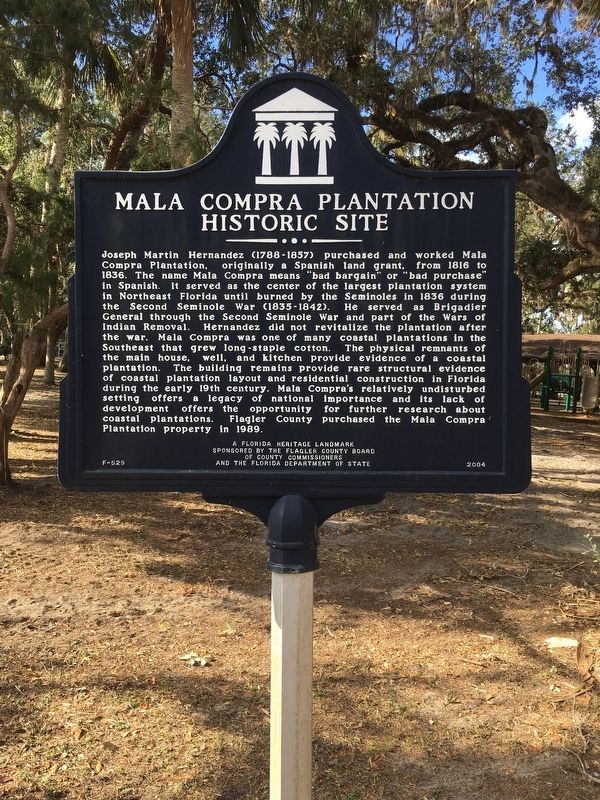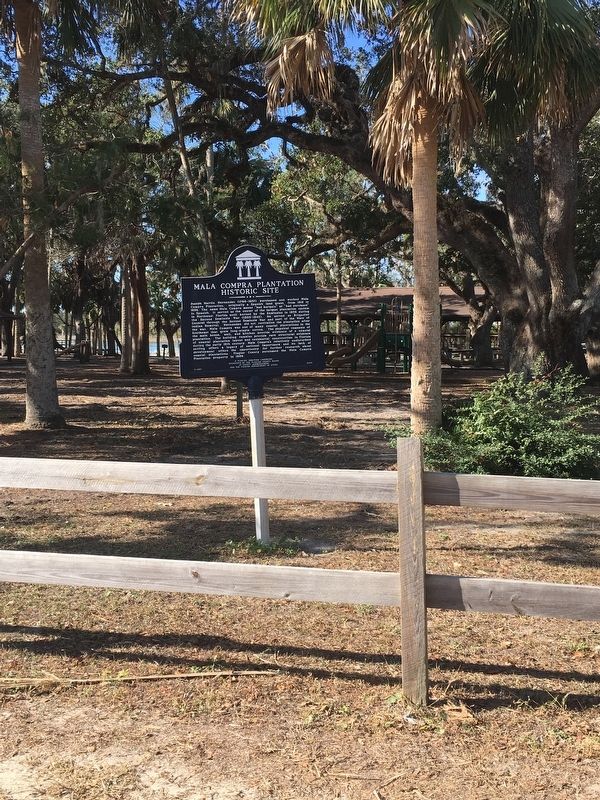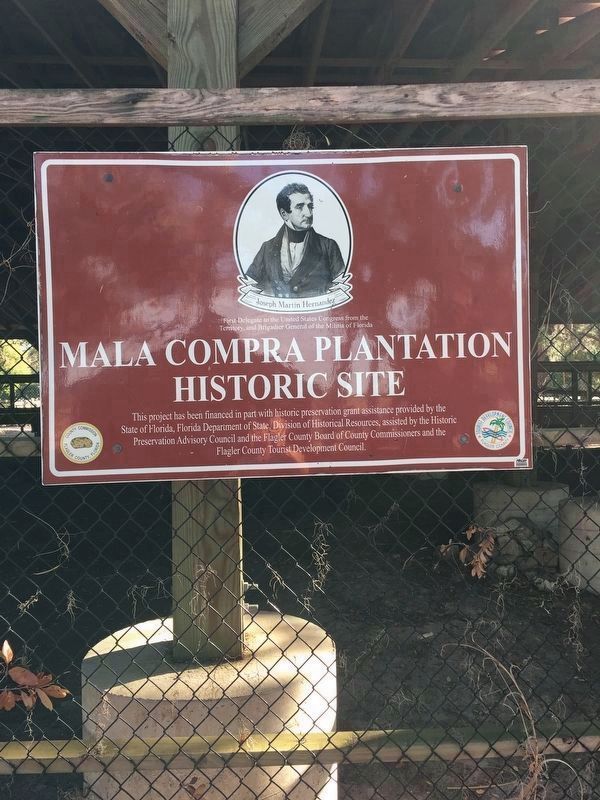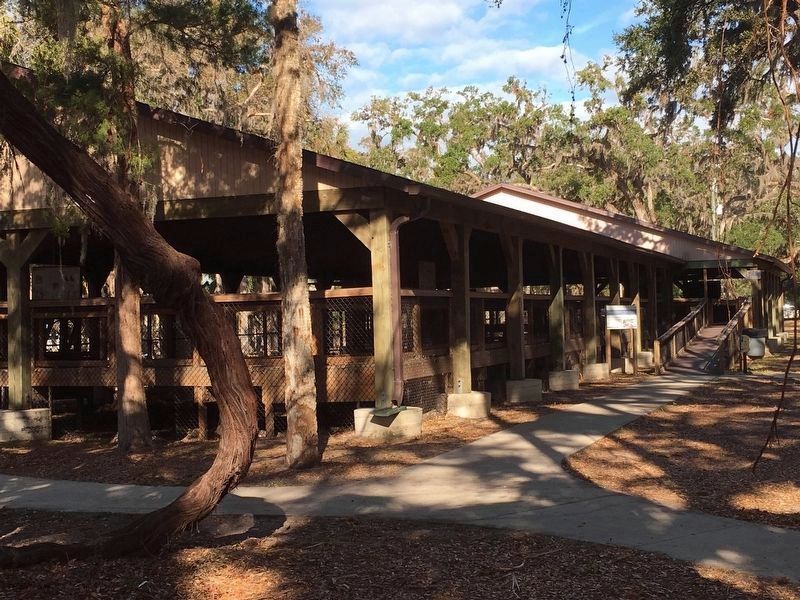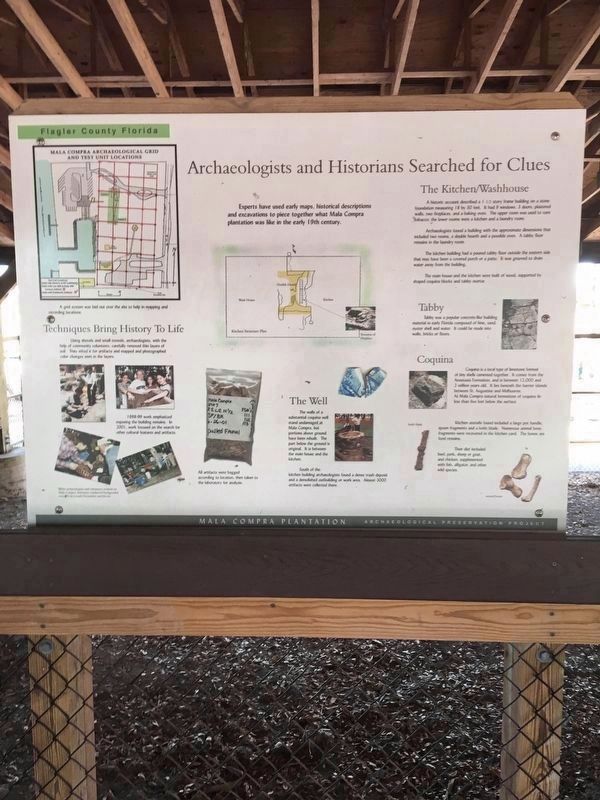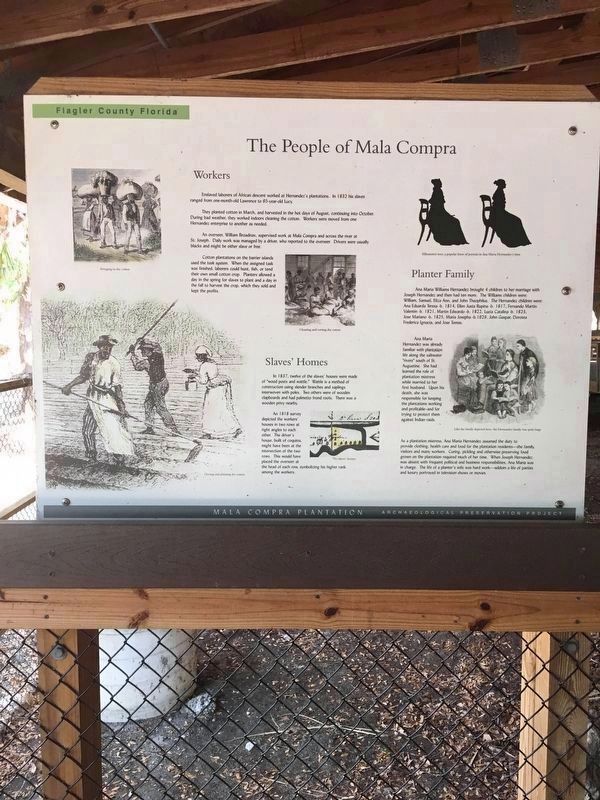Palm Coast in Flagler County, Florida — The American South (South Atlantic)
Mala Compra Plantation Historic Site
Erected 2004 by Flagler County Board of County Commissioners and the Florida Department of State. (Marker Number F-529.)
Topics. This historical marker is listed in these topic lists: Agriculture • Anthropology & Archaeology • Settlements & Settlers • Wars, US Indian. A significant historical year for this entry is 1816.
Location. 29° 36.963′ N, 81° 12.2′ W. Marker is in Palm Coast, Florida, in Flagler County. Marker is on North Ocean Shore Boulevard (State Road A1A) 0.1 miles north of Mala Compra Road, on the right when traveling south. Located in Bing's Landing park. Touch for map. Marker is at or near this postal address: 5862 N Ocean Shore Blvd, Palm Coast FL 32137, United States of America. Touch for directions.
Other nearby markers. At least 8 other markers are within one mile of this marker, measured as the crow flies. The Seminoles at Mala Compra (within shouting distance of this marker); Joseph Hernandez (within shouting distance of this marker); A Plantation in early Florida (within shouting distance of this marker); The Old Coast Guard Road (approx. ¾ mile away); What does Mala Compra Mean? (approx. 0.8 miles away); Coquina Columns (approx. one mile away); Washington Oaks Gardens (approx. 1.1 miles away); Young Home (approx. 1.1 miles away). Touch for a list and map of all markers in Palm Coast.
Also see . . .
1. Mala Compra Plantation Archeological Site
. Wikipedia (Submitted on November 27, 2016.)
2. Mala Compra. Flagler County Historical Society (Submitted on November 27, 2016.)
Additional commentary.
1. Text of additional marker "Archaeologists and Historians Look for Clues" (photo #5)
Experts have used early maps, historical descriptions and excavations to piece together what Mala Compra plantation was like in the early 19th century.
The Kitchen/Washhouse
A historic account described a 1 ½ story frame building on a stone foundation measuring 18 by 30 feet. It had 9 windows, 3 doors, plastered walls, two fireplaces, and a baking oven. The upper room was used to cure tobacco, the lower rooms were a kitchen and a laundry room.
Archaeologists found a building with the approximate dimensions that included two rooms, a double hearth and a possible oven. A tabby floor remains in the laundry room.
The kitchen building had a poured tabby floor outside the eastern side that may have been a covered porch or a patio. It was grooved to drain water away from the building.
The main house and kitchen were built of wood, supported by shaped coquina blocks and tabby mortar.
Tabby
Tabby was a popular concrete-like building material in early Florida composed of lime, sand, oyster shell and
water. It could be made into walls, bricks or floors.
Coquina
Coquina is a local type of limestone formed of tiny shells cemented together. It comes from the Anastasia Formation, and is between 12,000 and 2 million years old. It lies beneath the barrier islands between St. Augustine and Melbourne. At Mala Compra natural formations of coquina lie less than five feet below the surface.
The Well
The walls of a substantial coquina well stand undamaged at Mala Compra, but portions above ground have been rebuilt. The part below the ground is original. It is between the main house and the kitchen.
South of the kitchen building archaeologists found a dense trash deposit and a demolished outbuilding or work area. Almost 3000 artifacts were collected there.
Techniques Bring History To Life
Using shovels and small trowels, archaeologists, with the help of community volunteers, carefully removed the thin layers of soil. They sifted it for artifacts and mapped and photographed color changes seen in the layers.
1998-99 work emphasized exposing the building remains. In 2001, work focused on the search for other cultural features and artifacts.
Captions:
Kitchen utensils found included a large pot handle, spoon fragments and a knife blade. Numerous animal bone fragments were recovered in the kitchen yard. The bones are food
remains.
Their diet included beef, pork, sheep or goat, and chicken, supplemented with fish, alligator, and other wild species.
All artifacts were bagged according to location, then taken to the laboratory for analysis.
A grid system was laid out over the site to help in mapping and recording locations.
— Submitted August 1, 2017, by J. Makali Bruton of Accra, Ghana.
2. Text of additional marker "The People of Mala Compra" (photo #6)
Workers
Enslaved laborers of African descent worked at Hernandez’s plantations. In 1832 his slaves ranged from one-month-old Lawrence to 65-year-old Lucy. They planted cotton in March, and harvested in the hot days of August, continuing into October. During bad weather, they worked indoors cleaning the cotton. Workers were moved from one Hernandez enterprise to another as needed.
An overseer, William Broadnax, supervised work at Mala Compra and across the river at St. Joseph. Daily work was managed by a driver, who reported to the overseer. Drivers were usually blacks and might be either slave or free.
Cotton plantations on the barrier islands used the task system. When the assigned task was finished, laborers could hunt, fish, or tend their own small cotton crop. Planters allowed a day in the spring for slaves to
plant and a day in the fall to harvest the crop, which they sold and kept the profits.
Slaves’ Homes
In 1837, twelve of the slaves’ houses were made of “wood posts and wattle.” Wattle is a method of construction using slender branches and saplings interwoven with poles. Two others were of wooden clapboards and had palmetto frond roofs. There was a wooden privy nearby.
An 1818 survey depicted the workers’ houses in two rows at right angles to each other. The driver’s house, built of coquina, might have been at the intersection of the two rows. This would have placed the overseer at the head of each row, symbolizing his higher rank among the workers.
Planter Family
Ana Maria Williams Hernandez brought 4 children to her marriage with Joseph Hernandez and then had ten more. The Williams children were: William, Samuel, Eliza Ann, and John Theophilus. The Hernandez children were: Ana Eduarda Teresa –b. 1814, Ellen Justa Rupina –b. 1817, Fernando Martin Valentin –b. 1821, Martin Edwardo –b. 1822, Lucia Catalina –b. 1823, Jose Mariano –b. 1825, Maria Josepha –b. 1829, John Gaspar, Dorotea Frederica Ignacia, and Jose Tomas.
Ana Maria Hernandez was already familiar with plantation life along the saltwater “rivers” south of St. Augustine. She had learned the role of mistress while
married to her first husband. Upon his death, she was responsible for keeping the plantations working and profitable – and for trying to protect them against Indian raids.
As plantation mistress, Ana Maria Hernandez assumed the duty to provide clothing, health care and food for the plantation residents – the family, visitors and many workers. Curing, pickling and otherwise preserving food grown on the plantation required much of her time. When Joseph Hernandez was absent with frequent political and business responsibilities, Ana Maria was in charge. The life of a planter’s wife was hard work – seldom a life of parties and luxury portrayed in television shows and movies.
Captions:
Cleaning and sorting the cotton
The slaves’ houses
Hoeing and planting the cotton
Bringing in the cotton
Silhouettes were a popular form of portrait in Ana Maria Hernandez’s time.
Like the family depicted here, the Hernandez family was quite large. Note To Editor only visible by Contributor and editor
— Submitted August 1, 2017, by J. Makali Bruton of Accra, Ghana.
Credits. This page was last revised on May 3, 2018. It was originally submitted on November 25, 2016, by Brandon D Cross of Flagler Beach, Florida. This page has been viewed 2,212 times since then and 58 times this year. Photos: 1, 2, 3, 4, 5, 6. submitted on November 25, 2016, by Brandon D Cross of Flagler Beach, Florida. • Bernard Fisher was the editor who published this page.
